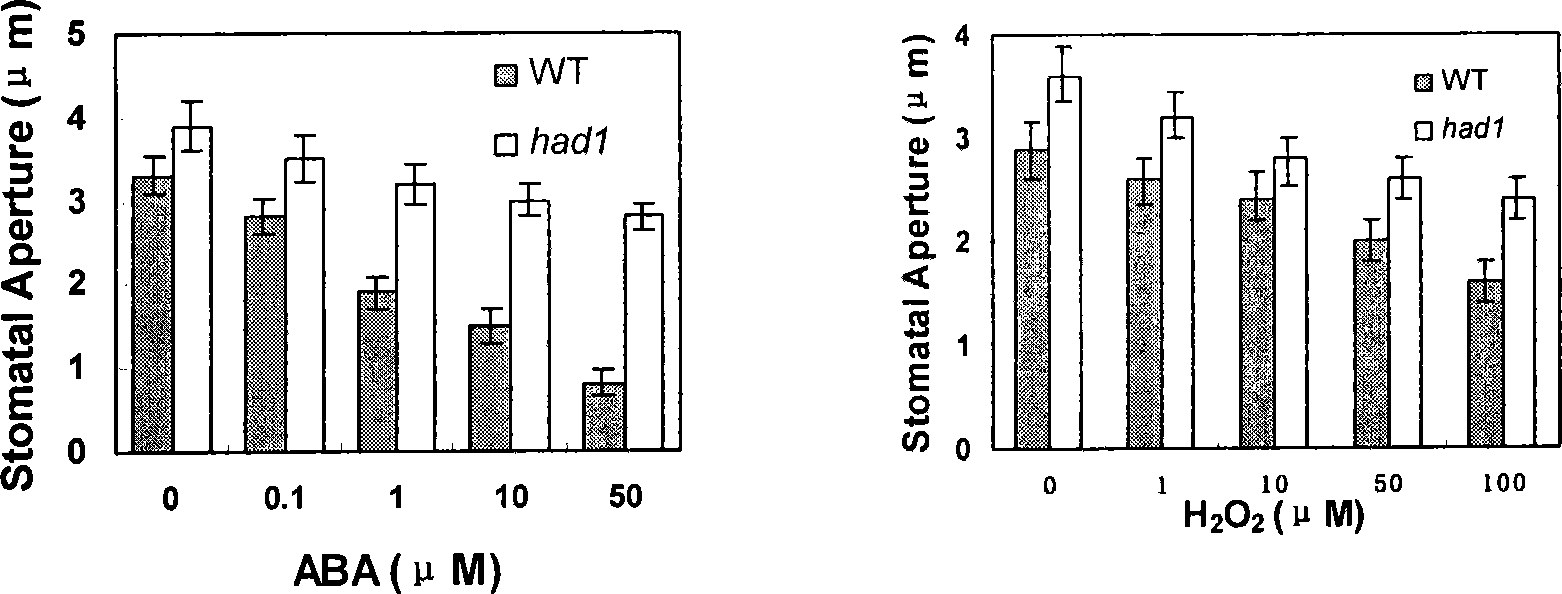Application of arabidopsis glutathione peroxidase gene HAD1 in anti-drought aspect for plant
A technology of glutathione peroxidase and anti-drought, applied in the field of genetic engineering
- Summary
- Abstract
- Description
- Claims
- Application Information
AI Technical Summary
Problems solved by technology
Method used
Image
Examples
Embodiment 1
[0015] Identification of HAD1 Gene Protein Activity
[0016] The method of expressing HAD1 protein in vitro was used to investigate whether it had peroxidase activity. The expression vector expressing HAD1 fusion protein was constructed with BL21 as the carrier, and expressed in Escherichia coli. Oxidase activity analysis, it is known that the consumption of NADPH required for the conversion of the two states of oxidation and reduction of glutathione peroxidase, under the excitation of 340nm wavelength, the absorbance value of NADPH can be measured, and its consumption can be calculated, namely The more NADPH is consumed, the higher the enzymatic activity of HAD1. The results showed that the prokaryotic expression of HAD1, Trx, TR, NADPH and H 2 o 2 In case of co-existence, OD 340nm Decreases continuously over time. When recording for 16 minutes, the OD value decreased by about 0.4, while there was only a small decrease when GSH was used as the electron donor. In addition...
Embodiment 2
[0018] In vivo expression of HAD1 gene
[0019] The HAD1 gene promoter and GUS fusion (pCMBIA1381 carrier) transgenic positive plants obtained by PCR amplification technology were used to detect the expression of HAD1 in different tissues of Arabidopsis thaliana. Histochemical staining showed that the whole The plants all have strong expression, and the GUS activity was measured in different tissues such as leaves, flowers, roots, stems, and pods. The results showed that the expression levels in leaves and roots were the strongest, while those in fruits, pods, stems, and flowers The expression is relatively weak; RT-PCR analysis of the transcription of HAD1 mRNA in different tissues also confirmed that the expression level in roots and leaves is higher; in addition, the expression level of HAD1 gene in plant guard cells is significantly higher than that of other isozyme genes .
Embodiment 3
[0021] Overexpression of HAD1 gene and molecular phenotype identification of mutants
[0022] In order to prove the function of HAD1 protein, its T-DNA insertion mutant (SALK_071176) was obtained from SALK laboratory, and its insertion site was located in the first exon; SALK laboratory provided the designed LP and RP double primer pair SALK_071176 was identified, and wild-type Arabidopsis genomic DNA was used as a template. PCR amplification results showed that there was an obvious band at 900bp, but SALK_071176 did not appear. In order to further identify homozygotes, the primers LBa1 and LBb1 designed on the left border of the T-DNA were used to carry out PCR reactions with the RP on the genome respectively, and two distinct lines were amplified at about 500bp and 700bp using the SALK_071176 plant genomic DNA as a template. The bands differ in size by about 200bp. In addition, RT-PCR analysis showed that the transcription of the mRNA of potential mutant HAD1 was terminated...
PUM
 Login to View More
Login to View More Abstract
Description
Claims
Application Information
 Login to View More
Login to View More - R&D
- Intellectual Property
- Life Sciences
- Materials
- Tech Scout
- Unparalleled Data Quality
- Higher Quality Content
- 60% Fewer Hallucinations
Browse by: Latest US Patents, China's latest patents, Technical Efficacy Thesaurus, Application Domain, Technology Topic, Popular Technical Reports.
© 2025 PatSnap. All rights reserved.Legal|Privacy policy|Modern Slavery Act Transparency Statement|Sitemap|About US| Contact US: help@patsnap.com


